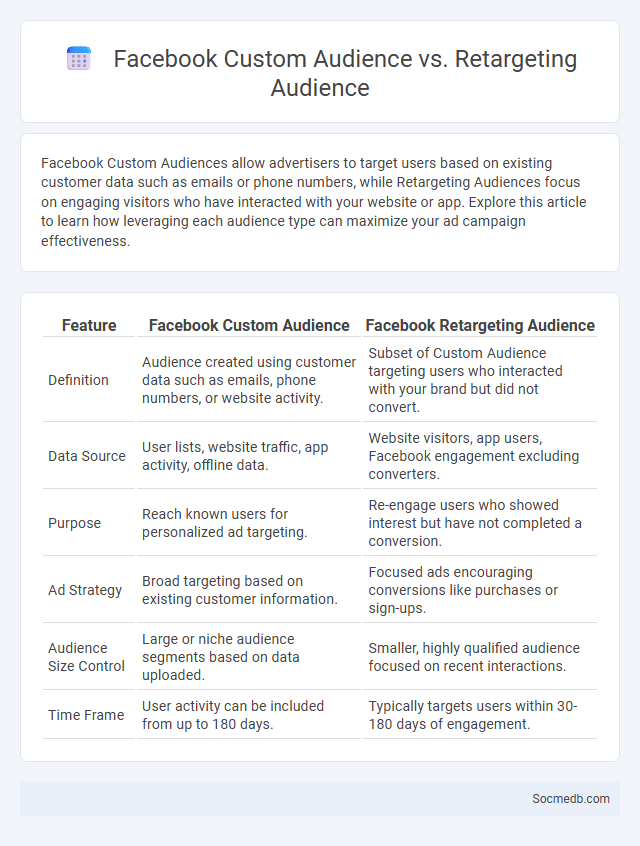
Photo illustration: Facebook Custom Audience vs Retargeting Audience
Facebook Custom Audiences allow advertisers to target users based on existing customer data such as emails or phone numbers, while Retargeting Audiences focus on engaging visitors who have interacted with your website or app. Explore this article to learn how leveraging each audience type can maximize your ad campaign effectiveness.
Table of Comparison
| Feature | Facebook Custom Audience | Facebook Retargeting Audience |
|---|---|---|
| Definition | Audience created using customer data such as emails, phone numbers, or website activity. | Subset of Custom Audience targeting users who interacted with your brand but did not convert. |
| Data Source | User lists, website traffic, app activity, offline data. | Website visitors, app users, Facebook engagement excluding converters. |
| Purpose | Reach known users for personalized ad targeting. | Re-engage users who showed interest but have not completed a conversion. |
| Ad Strategy | Broad targeting based on existing customer information. | Focused ads encouraging conversions like purchases or sign-ups. |
| Audience Size Control | Large or niche audience segments based on data uploaded. | Smaller, highly qualified audience focused on recent interactions. |
| Time Frame | User activity can be included from up to 180 days. | Typically targets users within 30-180 days of engagement. |
Introduction to Facebook Audiences
Facebook audiences allow advertisers to precisely target users based on demographics, interests, behaviors, and location, enhancing campaign effectiveness. Custom Audiences enable marketers to reconnect with existing customers, while Lookalike Audiences help discover new potential clients similar to current customers. Leveraging Facebook's detailed audience segmentation drives higher engagement and improves return on ad spend.
What is a Facebook Custom Audience?
A Facebook Custom Audience is a powerful advertising feature that allows businesses to target specific groups of users based on their existing relationships with the brand, such as email lists, website visitors, or app users. By uploading customer data securely to Facebook, advertisers can create highly personalized ad campaigns that increase relevance and conversion rates. This targeting method enhances engagement by reaching people who have already demonstrated interest in a product or service.
What is a Facebook Retargeting Audience?
A Facebook Retargeting Audience consists of users who have previously interacted with your website, app, or Facebook content, enabling precise ad targeting based on their prior engagement. This audience is created through the Facebook Pixel or SDK, which tracks user behavior such as page visits, cart additions, or specific actions, allowing advertisers to deliver personalized ads that increase conversion rates. Leveraging retargeting audiences effectively helps businesses maximize ad spend efficiency by reaching potential customers who have already shown interest in their products or services.
Key Differences: Custom Audience vs Retargeting Audience
Custom Audience targets specific users based on data you provide, such as email lists, phone numbers, or app activity, allowing you to reach existing customers or leads. Retargeting Audience focuses on users who have previously interacted with your website or social media content, enabling you to re-engage potential customers through personalized ads. Understanding these distinctions helps you optimize your social media campaign by tailoring your message to either a known customer base or individuals showing prior interest.
Audience Creation Process: Step-by-Step Comparison
The Audience Creation Process on social media involves identifying target demographics, analyzing user behavior, and segmenting followers for tailored content delivery. You optimize engagement by using tools like Facebook Audience Insights or Twitter Analytics to refine audience characteristics and adjust campaigns accordingly. Comparing these steps across platforms highlights different data points and customization options critical for precise targeting and maximizing reach.
Use Cases for Facebook Custom Audiences
Facebook Custom Audiences enable precise targeting by allowing businesses to reach existing customers and lookalikes based on email lists, website traffic, or app activity. Your campaigns benefit from improved conversion rates as you tailor ads to specific user behaviors and demographics. This targeted approach enhances return on ad spend (ROAS) through personalized engagement and retargeting strategies.
Use Cases for Facebook Retargeting Audiences
Facebook retargeting audiences enable businesses to reconnect with users who have previously engaged with their website, app, or social media content, boosting conversion rates by targeting high-intent prospects. Use cases include recovering abandoned shopping carts, promoting new product launches to past purchasers, and upselling complementary services to loyal customers. Leveraging Facebook Pixel data and Custom Audiences, marketers can optimize ad spend and personalize campaigns based on user behavior and demographic insights.
Pros and Cons: Custom vs Retargeting Audiences
Custom audiences enable precise targeting by leveraging existing customer data to create personalized ad campaigns, improving conversion rates and ROI. Retargeting audiences capture users who have previously engaged with a brand, increasing brand recall and driving higher engagement through tailored ads. However, custom audiences require substantial data management and privacy compliance, while retargeting may lead to ad fatigue or negative user experience if overused.
Best Practices for Audience Segmentation
Effective audience segmentation on social media involves categorizing your followers based on demographics, interests, and behaviors to deliver personalized content that resonates. Utilizing data analytics tools helps identify key segments, enabling you to tailor campaigns for higher engagement and conversion rates. By understanding your audience's unique preferences, your social media strategy becomes more targeted and impactful.
Choosing the Right Audience Strategy for Your Campaign
Choosing the right audience strategy for your social media campaign ensures targeted engagement and maximizes return on investment. Utilizing data-driven insights and platform-specific demographics helps you tailor content to the most relevant users. Your campaign's success depends on aligning audience segmentation with your brand goals and message.
 socmedb.com
socmedb.com